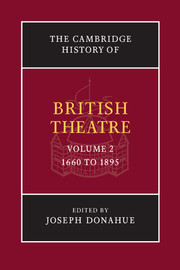Book contents
- Frontmatter
- Part I 1660 to 1800
- Part II 1800 to 1895
- 11 Introduction: the theatre from 1800 to 1895
- 12 Presence, personality and physicality: actors and their repertoires, 1776–1895
- 13 Theatres, their architecture and their audiences
- 14 Stage design from Loutherbourg to Poel
- 15 Theatre and mid-Victorian society, 1851–1870
- 16 Gendering Victorian theatre
- 17 Popular entertainment, 1776–1895
- 18 The Bells: a case study A ‘bare-ribbed skeleton’ in a chest
- 19 The new drama and the old theatre
- 20 1895 A critical year in perspective
- Bibliography
- Index
- References
13 - Theatres, their architecture and their audiences
from Part II - 1800 to 1895
Published online by Cambridge University Press: 28 March 2008
- Frontmatter
- Part I 1660 to 1800
- Part II 1800 to 1895
- 11 Introduction: the theatre from 1800 to 1895
- 12 Presence, personality and physicality: actors and their repertoires, 1776–1895
- 13 Theatres, their architecture and their audiences
- 14 Stage design from Loutherbourg to Poel
- 15 Theatre and mid-Victorian society, 1851–1870
- 16 Gendering Victorian theatre
- 17 Popular entertainment, 1776–1895
- 18 The Bells: a case study A ‘bare-ribbed skeleton’ in a chest
- 19 The new drama and the old theatre
- 20 1895 A critical year in perspective
- Bibliography
- Index
- References
Summary
On 8 November 1755, at Drury Lane, Garrick introduced a French company performing Jean Georges Noverre’s ballet The Chinese Festival—to the mounting displeasure of a xenophobic audience, hissing, clapping and crying ‘No french Dancers’. By the fifth night a riot was underway, and the sixth night proved to be the last. A contemporary print depicts several members of the audience, one wielding a club, moving through the orchestra pit and up onto the stage. At either side of the forestage appears an ornamental barrier, and the stage boxes, just below the proscenium doors, are outlined by rows of spikes — largely symbolic, to judge from the ease with which they are being breached. The audience’s agitation is highlighted by the five chandeliers above the scene, four in parallel and another in the centre. Candles in pairs, four sets at either side of the downstage area, also record the artist’s attempt to indicate the full illumination of forestage and auditorium.
The illustration epitomizes a widely held view of the eighteenth-century theatre audience as an unruly mob, an image captured here for posterity on one of those occasions when an ordinarily vociferous audience became indignant over some perceived insult or other failure to defer to their tastes and preferences, and reacted accordingly. Over against such images should be placed depictions of other moments in which that same autocratic audience expressed its pleasure in universal laughter or applause, as in Hogarth’s robust representation of a London theatre audience in 1733. Both images are true, and equally characteristic of that open-hearted (if not open-minded) cohort of citizens from various walks of life who attended the theatre as often as they could and who insisted on being well entertained.
- Type
- Chapter
- Information
- The Cambridge History of British Theatre , pp. 292 - 308Publisher: Cambridge University PressPrint publication year: 2004

